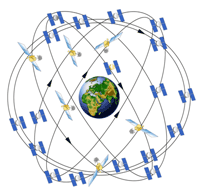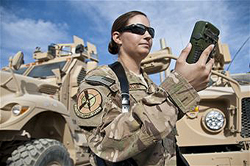COMING UP in the May/June 2008 issue. . .
To advertise, contact gl**@********ss.com
Find out more about advertising
COVER STORY
From RAIM to NIORAIM: A New Approach to Integrity Using Multiple GNSS Systems
Patrick Hwang and Grover Brown
COMING UP in the May/June 2008 issue. . .
To advertise, contact gl**@********ss.com
Find out more about advertising
COVER STORY
From RAIM to NIORAIM: A New Approach to Integrity Using Multiple GNSS Systems
Patrick Hwang and Grover Brown
Navigation systems engineers will soon have more pseudorange measurements from more GNSS systems than anyone could have dreamed a few years ago. This new wealth of measurement redundancy could make RAIM (Receiver Autonomous Integrity Monitoring) a more robust means of assuring system integrity. Usually, the more measurements there are, the better the solution – but there are subtle considerations of how to combine them in the case of integrity monitoring. The authors apply a new approach, Novel Integrity Optimized RAIM (NIORAIM), to the problem.
TECHNICAL ARTICLES
All Aboard! Integrating SAASM and Commercial GPS Receivers with Legacy Shipboard Navigation and Weapons Systems
Bill Woodward
Advances in technology make earlier systems obsolete. However, in military and other platforms that must meet stringent interface and installation standards, it’s not possible to swap old for new. In this article, the author describes the engineering challenges his company faced when they designed, tested, installed and trialed a gateway between Satellite Signals Navigation Set legacy shipboard equipment and newer SAASM military and commercial GPS receivers.
GIOVE-B on the Air: Understanding Galileo’s New Signals
Grace Xingxin Gao, Stanford University; Dennis M. Akos, University of Colorado at Boulder; Todd Walter, Stanford University; Per Enge, Stanford University
Following up on their earlier work analyzing and decoding new GNSS signals, researchers from Stanford University and the University of Colorado provide an early analysis of signals being transmitted by the latest Galileo satellite, GIOVE-B.
COLUMNS
GNSS Solutions
What are the Wide Area Augmentation System (WAAS) GEOs’ L1 and L5 differential biases and how are they estimated? Do GNSS augmentation systems certified for aviation use, like WAAS, have a function other than improving the accuracy of user navigation? Columnists Gérard Lachapelle and Mark Petovello asked Mohinder Grewal and Jason Rife to answer these questions.
GNSS Solutions home page
Working Papers
Using GNSS Indoors – Fighting the Fading, Part 2
Günter Hein, Matteo Paonni, Victoria Kropp, and Andreas Teuber
The conclusion of this two-part series focuses on ways to improve the performance of low-power GNSS signals indoors. Using transmissions from a helicopter-borne pseudolite, the researchers explore the behavior of the actual Galileo signal as it propagates through the walls of a building, examining the effects on signal power levels and the appearance of the signal spectra in that environment. The properties of building materials are also investigated in greater detail.
Working Papers home page
Book Reviews
Spread Spectrum Systems for GNSS and Wireless Communications,
by Jack K. Holmes
Reviewed by Phil Ward
GNSS Aided Navigation & Tracking,
by James L. Farrell
Reviewed by Christopher Hegarty





